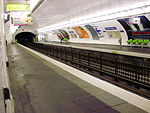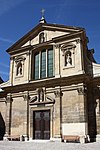Carmes Prison
Persecution of CatholicsPrisons in ParisReligion and the French Revolution

The Carmes Prison (French - prison des Carmes) was a prison of the French Revolution. It was set up in what had been the Carmes Monastery in Paris. It formed a vast enclosure bounded by rue du Regard, rue du Cherche-Midi and rue Cassette - it was also bordered to the south by rue de Vaugirard. It was the site of one of the September Massacres in 1792 and features in the 1927 film Napoléon.
Excerpt from the Wikipedia article Carmes Prison (License: CC BY-SA 3.0, Authors, Images).Carmes Prison
Rue Cassette, Paris 6th Arrondissement (Paris)
Geographical coordinates (GPS) Address Nearby Places Show on map
Geographical coordinates (GPS)
| Latitude | Longitude |
|---|---|
| N 48.85 ° | E 2.33 ° |
Address
Institut Catholique de Paris
Rue Cassette
75006 Paris, 6th Arrondissement (Paris)
Ile-de-France, France
Open on Google Maps










